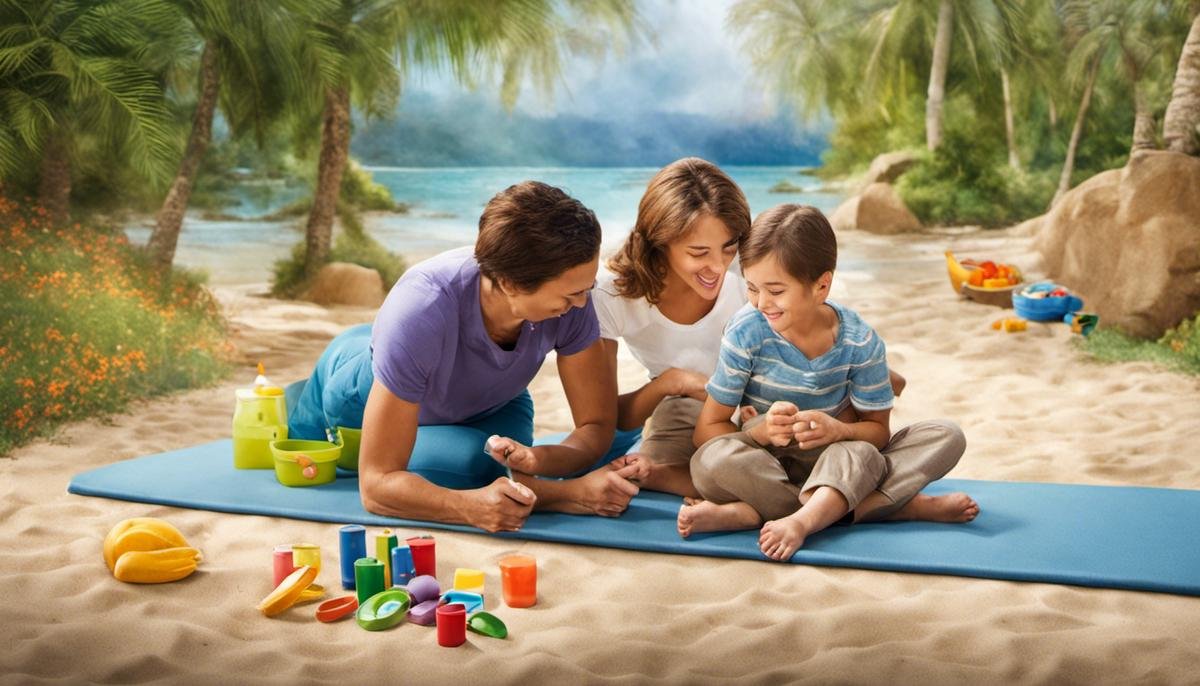
For many families embarking on the journey of Applied Behavior Analysis (ABA) Therapy, the path may seem complex and filled with unfamiliar terms and goals. ABA therapy can serve as an essential tool to equip children, particularly those with autism spectrum disorder, with vital behavioral skills. This therapy technique is tailored to improve both basic and complex behaviors such as eye contact, social skills, and self-reliance. The purpose of our discussion is to shed light on the intricacies of ABA Therapy, the milestones to look forward to, and how families can actively participate and adapt to the implied changes.
Understanding ABA Therapy
Title: Unlocking the Potential with ABA Therapy
Every parent’s dream is seeing their child grow, prosper and navigate life successfully. However, sometimes, life comes with its own set of challenges that necessitate a little extra support. For families with children diagnosed with Autism Spectrum Disorder (ASD), these challenges may require additional therapeutic interventions. One highly effective strategy used to guide youngsters with ASD is Applied Behavior Analysis (ABA) therapy. Let’s delve into the world of ABA therapy and discover why it’s considered a vital tool in aiding growth and development.
ABA therapy, in a nutshell, is a scientific approach to understanding and modifying behavior. It revolves around the idea that behaviors, both advantageous and disadvantageous, are learned and can be changed over time. In practice, this equates to using positive reinforcement techniques to encourage desired behaviors in children with ASD.
The beauty of ABA therapy is its adaptability. It can be applied across various settings – from the comfort of the home to the school, or even community environments. This flexibility means that children can learn essential skills simultaneously adapted to different situations, making it easier to master and maintain those skills over time.
But why is ABA therapy considered crucial? The answer lies in its outcomes. ABA therapy is renowned for bringing about significant developments in communication, social relationships, self-care, play, and leisure skills. It serves as a transformative guide, helping kids with ASD learn new skills, reduce undesirable behaviors, and, most importantly, become more independent in their daily lives.
Moreover, ABA therapy is backed by countless empirical research showcasing its success in improving the quality of life for children with ASD and their families. It’s a therapy that doesn’t just focus on the child; it involves the whole family, empowering parents with practical strategies to support their child’s journey positively.
Crucially, ABA therapy emphasizes the importance of early intervention. Earlier the therapy is introduced, better the outcomes tend to be. The reason for this is simple: young children’s minds are still forming, making it an ideal time to introduce and reinforce targeted behaviors.
However, it’s essential to remember that each child is unique, and so are their needs. The effectiveness of ABA therapy often relies on a customized approach, recognizing the child’s unique traits, interests, challenges, and potential. The therapeutic journey should always be personalized and tailored to match the child’s needs and character.
ABA therapy stands as a beacon of hope for many families dealing with ASD. It empowers, it educates, and it promotes growth. So the next time someone asks about the importance of ABA therapy, let them know: it’s about much more than ‘therapy.’ It’s about kindling potential, fostering independence, building skills, and above all, shaping brighter futures for our most precious stars.

Photo by levimeirclancy on Unsplash
Key Milestones in ABA Therapy
The Journey through ABA Therapy: Major Milestones to Watch For
ABA therapy is a remarkable tool, known for its adaptability and customization according to individual needs, which is why it’s hailed as a beacon of hope for families navigating the waters of Autism Spectrum Disorder (ASD). However, just like in every journey, there are significant milestones to watch for in ABA therapy. Knowing these milestones can make a world of difference by helping parents and caregivers monitor progress, set realistic expectations, and celebrate small victories along the way.
The first major milestone is known as the assessment phase. This serves as the blueprint for the entire therapeutic process. During this initial stage, a Board Certified Behavior Analyst (BCBA) observes the child’s behavior in various contexts. The goal is to pinpoint specific areas that need improvement and understand the different factors that may trigger certain behaviors. Based on this comprehensive evaluation, a methodology and a unique plan of care will be crafted, tailored to the child’s unique abilities and needs.
The second milestone to look forward to is the implementation of the individualized plan. Here, the methods decided upon are put into action. Recognizable progress may not come overnight, but this phase is vital because it’s where the techniques of behavior modification are applied with consistency, which over time, leads to change.
The third milestone, of course, is progress. Now, progress can look a lot different than one might expect. It’s important to remember that any movement towards the behavioral goals, no matter how small, is a sign of progress. So, from an increase in positive social interactions and communication skills to improvements in self-reliance, every baby step forward is a significant achievement.
Then we have the generalization phase, another critical milestone, where children transfer the skills they’ve learnt during therapy, using them in real-world environments. This is a promising sign that ABA therapy is indeed effective, as it shows that the child is able to adapt behaviors in a wider variety of settings, such as at school, home, or in the playground.
The last milestone is maintenance, marked by the child’s sustained positive behavior even after therapy sessions have concluded. Maintenance success truly embodies the power of ABA therapy, as it underscores the development of lifelong skills that continue to assist the child and their family, even beyond the intensive therapy period.
It’s essential not to get caught up along the way, comparing one child’s progress with another. Every child has their own pace and path in this journey, and that’s completely okay! Stay supportive and patient. Cherish the milestones and remember to celebrate every bit of progress. ABA Therapy is a marathon, not a sprint, and in this marathon, every step—no matter how tiny—is worth its weight in gold.

Tracking Progress in ABA Therapy
Measuring the Progress in ABA Therapy
In the world of autism therapy, there’s a lot to sink your teeth into about Applied Behavioral Analysis (ABA), a gold standard for treating children with Autism Spectrum Disorder (ASD). As discussed earlier, ABA therapy is a broad umbrella of techniques focused on modifying behaviors using positive reinforcement. The therapy is adaptable across diverse settings and leads the way to improved communication, social relationships, self-care, and play skills. These benefits serve as a beacon of hope for families navigating the ASD journey.
If you’re a parent walking this path, here’s where the beauty of ABA therapy truly shines – in its measurable results. This article will help shed light on how progress in ABA therapy can be measured.
The Assessment Phase
Before embarking on any journey, understanding the starting point is essential, and ABA therapy is no different. An initial assessment by an experienced Behavioural Analyst is the first step in gauging the child’s existing skillsets. It helps identify areas that need improvement. This assessment serves as the baseline for therapists to gauge success and adjust the treatment plan accordingly.
Individualized ABA Plan
Equipped with initial assessment details, the therapy team designs an individualized ABA plan tailoring intervention strategies suitable for the child’s unique needs. A well-structured plan will identify specific, measurable targets in areas like communication or social interactions. The real beauty of ABA therapy is how meticulously the goals are broken down into manageable tasks.
The Progress
Now how do we measure the progress? Much like a well-formed game plan, the actual progress is measurable at every stage of ABA therapy. Each task achieved is a victory, and its consistent achievement signifies progress. These tasks, no matter how small, lay the groundwork towards achieving larger, long-term goals. The documentation of each completed task aids in tracking the progress in real-time and provides a cohesive picture of the child’s improvements.
Generalization Phase
The generalization phase is another unique method of measuring progress in ABA therapy. It doesn’t merely focus on the child learning a new skill but also emphasizes on the transference of this new skill across a variety of settings and contexts. Generalization reflects the child’s adaptability, and their ability to apply learned behaviors in different situations proves successful ABA therapy.
Maintenance
As ABA therapy progresses, the aim turns towards maintaining the learned skills over time. While we want our young ones to acquire new abilities, it’s equally important to ensure they retain these skills in the longer term. Regular assessments aid in measuring this progress, ensuring the child has internalized the behavior enough to continue demonstrating it with consistency, even when direct therapy is reduced.
Like a puzzle, every piece or tactic in ABA therapy is a crucial step in shaping the bigger picture. It’s so fulfilling to see our children, each unique and wonderful in their way, flourish and cultivate vital skills they will use for the rest of their lives. Remember, ABA therapy is not a sprint; it’s a marathon, taking patience, time, and celebration of every little victory along the way. Let’s keep the hope alive, always.

Adapting to Hurdles in ABA Therapy
Navigating Challenges during ABA Therapy
ABA therapy is incredibly effective, but it doesn’t happen overnight. Much like other forms of progression, it takes perseverance. As a parent, it’s normal to experience challenges and setbacks during this process. However, it’s how we manage those challenges that makes all the difference.
The Process Can Feel Overwhelming
ABA therapy heavily relies on accurate data collection, which can seem daunting for many parents. Hours are filled with observing, tracking, and recording behaviors to support treatment goals. But rather than seeing data collection as a chore, think of it as a roadmap. It shows where your child is at, where they are headed, and what needs to be refined along the way. This perspective turns an overwhelming task into a fundamental tool in your child’s journey.
Change Can Be Stressful–For Everyone
Just like any new learning experience, the changes accompanying ABA therapy can ignite all sorts of emotions in both you and your child. These can range from stress and anxiety to excitement and relief. Remember, your emotions are valid and another step on this journey. Use any support available to you–whether that’s family, professionals, or just some trusted friends.
Patience is Key
ABA doesn’t promise overnight results. It takes continuous efforts and undying patience for noticeable improvements to appear. It’s important to remember that ABA is not a sprint; it’s a marathon. Small steps of progress, no matter how minor, are still positive strides to celebrate.
Maintaining the Balance
Finding the right balance between ABA therapy, family time, and other life responsibilities can be a steep hill to climb. Fitting ABA sessions into your schedule while ensuring your child is not overwhelmed is a balancing act. It is essential to keep a flexible approach, recognizing when to push for progress and when to scale back and give your child a break.
Lastly, Trust the Process
ABA is a systematic, practical, and research-based approach that has transformed many lives. The process may seem istubborn or daunting, but sticking to the plan and trusting in the expertise of your ABA professional can make this bumpy ride smoother and more manageable. This process will undoubtedly stretch your patience to its limits, but keep in mind that this is an investment for your child’s future — a future filled with the life skills they’ll need to thrive.
Navigating the challenges of ABA therapy requires patience, understanding, and good communication. It’s a journey filled with ups and downs, but remember–every step forward is worth celebrating. Your efforts and dedication are making a world of difference in your child’s life. Keep going! You’ve got this!

ABA and Family Life
Incorporating ABA Therapy into Your Everyday Rhythm
While the concept and aims of ABA therapy can seem like a substantial topic, the application can be worked seamlessly into your daily family life. The home merely becomes an extended classroom, where lessons learned in therapy sessions echo throughout your regular routines.
In ABA therapy, patience is the key, but with a supportive network, it doesn’t need to be a solo journey. Collaborating with a team of therapists and experts can help to chart a customized plan that aligns with your child’s unique needs. Regular communication with this team can alleviate the overwhelming nature of data collection, providing graphical records and progress reports to visualize your child’s improvements over time.
Home life is where real-life scenarios exist, presenting an opportunity to apply learned behaviors in different settings. This is the ‘generalization phase’ of ABA therapy, where the focus is on making connections between skills learned in therapy sessions and their application in the day-to-day family environment. Initiating simple practices at home, such as assisting with setting the table or brushing teeth, can significantly contribute to your child’s progress.
Don’t be discouraged when progress seems slow. Managing emotions and stress during the therapy process has its mountains and valleys. Recognize that progress isn’t always linear. Look for the small victories. Even the simplest tasks achieved, like completing a puzzle or cooperative play during a sibling’s game, can be considered a victory. Celebrating these mini achievements can reinforce the therapy process, promoting continual growth.
Moreover, it’s crucial to find a healthy balance. While ABA therapy will naturally play a significant role in your daily routine, you also need to find time for other life responsibilities. Scheduling therapy sessions around school hours, carving out time for leisure, and arranging breaks in the treatment plan can help ensure that your family remains happy, engaged, and revitalized.
Trust the process. Professional ABA therapists are there to guide your journey, offering advice and techniques tailored to your child’s specific needs. Beyond therapy sessions, these experts often provide valuable resources for further learning and encourage your involvement in autism-related organizations. This network can be an invaluable support system, ensuring you don’t walk this path alone.
In conclusion, remember that every family’s experience with ABA therapy is unique. It’s essential to honor your individual journey, the pace of your child, and the unique dynamics of your family. When implemented consistently and lovingly, ABA therapy can seamlessly blend into your daily rhythm, leading to substantial growth for your child and your family as a whole. Remember, you’re laying down stepping stones for a brighter future, one day at a time.

It’s essential to remember that each child’s learning journey is unique and progress may not always be linear. Despite the inevitable hurdles, ABA therapy provides a foundation for positive behavioral changes that can significantly improve the quality of life for children with autism and their families. ABA therapy, when complemented by a conducive home environment and family support, can empower these children to achieve their full potential. It’s a journey filled with growth, learning, and triumphs that will shape a brighter future for your child.




